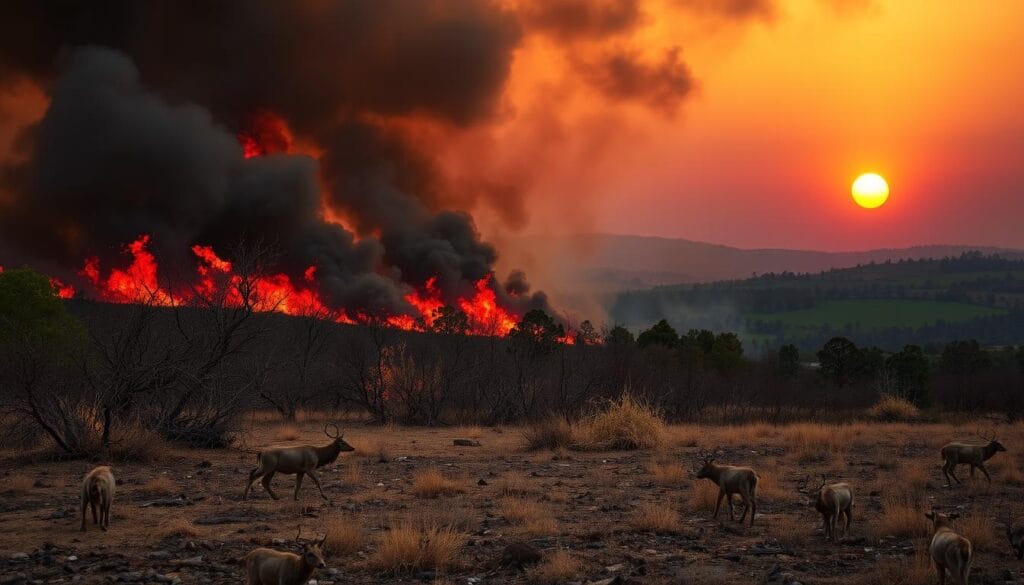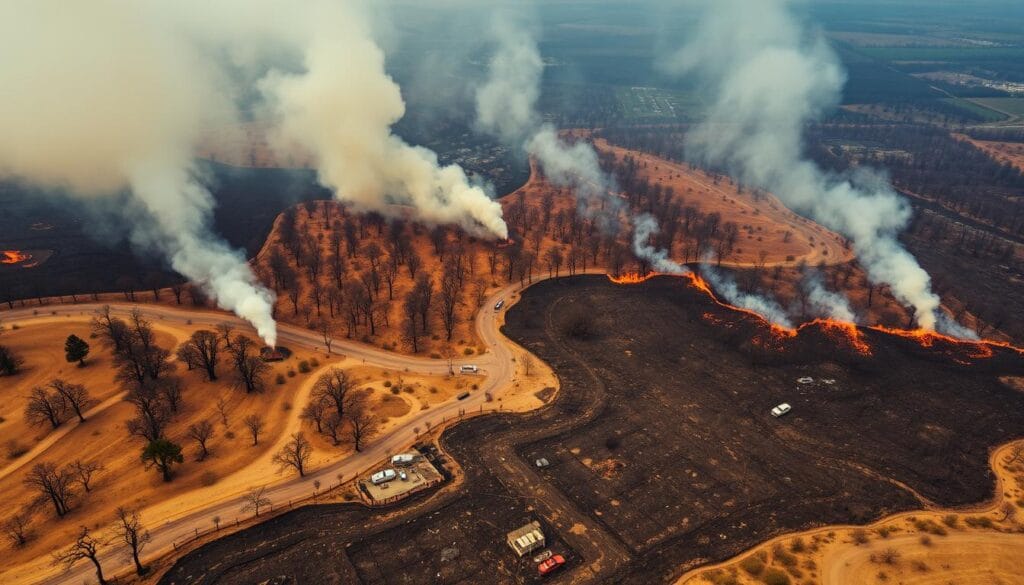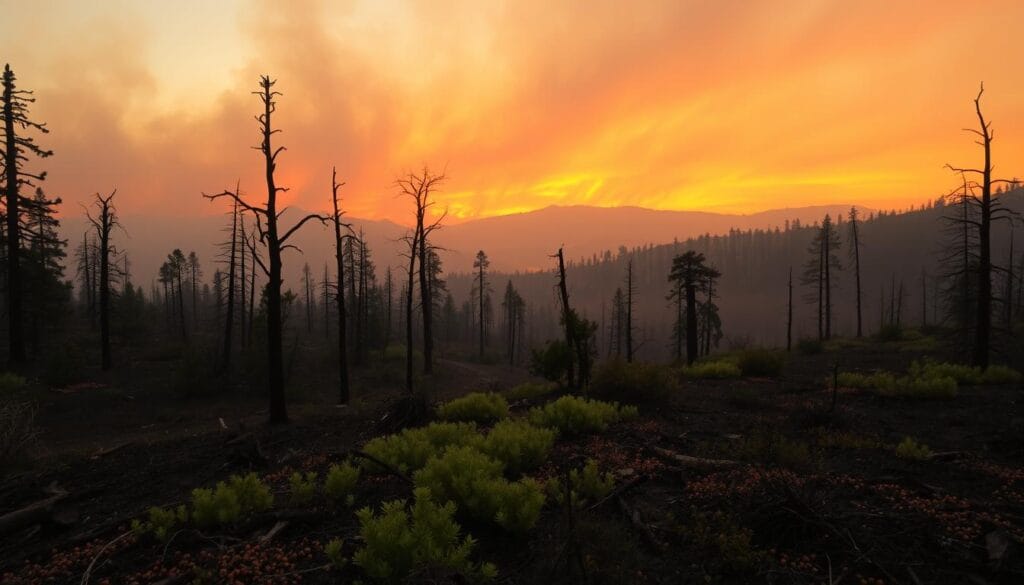Table of Contents
Did you know over 200,000 people have been evacuated in Los Angeles County due to wildfires? This shows the crisis California faces every year during wildfire season1. It’s vital to stay updated on fire conditions, their impact, and how to protect our communities from fire damage.
Recent fires have destroyed thousands of acres in places like Pacific Palisades and Malibu1. Many homes have been lost, and thousands more are at risk. Understanding the fires’ extent is more important than ever. This article will give you the latest on fires, insights into wildfire season, and safety tips. Being aware and prepared can help us get through these tough times.
Key Takeaways
- Over 200,000 individuals evacuated due to ongoing wildfires.
- Thousands of acres destroyed in key areas such as Malibu and Altadena.
- Emergency preparedness is vital during the wildfire season.
- Thousands of homes face destruction, with many already lost.
- Staying informed about current fire conditions is crucial for safety.
Current California Fires Overview
The Eaton and Palisades fires in California have caused a lot of damage in Los Angeles County. They have burned tens of thousands of acres. Over 200,000 people have been evacuated, and many homes are at risk or have been destroyed1.
About 7,081 structures have been damaged or destroyed by the Eaton Fire alone2. Pacific Palisades, Malibu, and Santa Monica have seen a lot of damage1.
The Eaton Fire has burned 13,956 acres and is only 3% contained. The Palisades Fire has burned 21,317 acres and is 8% contained2. These fires are unpredictable and continue to grow.

We are hopeful that containment efforts will improve soon. Mandatory evacuation zones have been set up in areas like Brentwood and Encino2. It’s important to stay informed and prepared.
There are many ways to help those affected by the fires. Our community is showing great strength in this difficult time. Visit this link to learn how you can contribute.
Understanding Wildfire Season in California
California’s wildfire season is shaped by its Mediterranean climate. This climate brings hot, dry summers and wet winters. It makes the state prone to wildfires, which are worsened by droughts.
Recently, Southern California has seen over 10,000 homes burned by wildfires since January 7, 20253. High winds and rising temperatures increase the risk of wildfires. It’s important to know the wildfire causes to prepare for future fires.
Looking back, we see the need for better wildfire management. For example, Pacific Palisades faced its worst wildfire, destroying entire neighborhoods4. Families had to evacuate quickly, often with only their pets4. Dealing with the aftermath, like insurance issues and rebuilding, is tough.

California’s dry conditions lead to intense, fast fires. This is due to dry grasses and fuels around us. Since October, Downtown Los Angeles has seen very little rain, adding to the fire danger5. Also, La Niña usually means less rain for Southern California, but NOAA predicts a change5.
Knowing about wildfire season helps us protect our communities and homes. With this knowledge, we can take steps to safeguard our areas in California’s challenging climate.
The Devastating Impact of Recent California Fires
The recent wildfires in California, like those in Los Angeles, have caused huge damage. Entire neighborhoods have been destroyed, leaving deep scars. The Eaton Fire, for example, has burned over 13,956 acres and damaged about 7,081 structures. Sadly, it has also caused six fire-related deaths and injured firefighters2.
These fires have burned over 34,000 acres in just a few days. They are among the most destructive in California’s history6. The damage has affected many families, with over 12 schools destroyed and more than 5,600 students displaced6. The local economy is also suffering, with estimated damages and losses reaching up to $150 billion.
The impact of these fires goes beyond physical damage. The emotional toll on residents is huge. Many face the loss of their homes and struggle with trauma and uncertainty. The cost of rebuilding is high, and the community will need time to recover.

| Fire Name | Acres Burned | Containment | Structures Damaged | Fire-Related Deaths |
|---|---|---|---|---|
| Eaton Fire | 13,956 | 3% | 7,081 | 6 |
| Palisades Fire | 21,317 | 8% | 5,316 | 5 |
| Kenneth Fire | 1,052 | 50% | N/A | N/A |
| Hurst Fire | 771 | 70% | N/A | N/A |
| Lidia Fire | 395 | 75% | N/A | N/A |
The aftermath of these tragedies shows we need support and community help. We must come together to face these challenges. It’s also important to remember the bravery of firefighters who risk their lives to fight the fires.
California Fires: Latest Updates on Ongoing Blazes
The california fires updates show a critical situation with many major fires causing a lot of damage. Two fires in the greater Los Angeles area are causing a lot of concern.
Major Fires Currently Burning
The Palisades Fire is burning the Pacific Palisades neighborhood. It has burned over 21,000 acres and is only 8% contained78. The Eaton Fire in Altadena has burned nearly 14,000 acres and is only 3% contained78. This has led to mandatory evacuations from Sunset Boulevard to the Encino Reservoir and near Interstate 405.
Casualty and Damage Reports
The wildfires have caused a lot of sadness, with at least 11 confirmed deaths7. Over 12,000 structures have been destroyed, with Altadena losing over 7,000 structures7. Firefighters face challenges like drones and strong winds, making their job harder7.

Emergency Preparedness for California Residents
Wildfires are a big threat, and we must be ready to keep our communities safe. Over 200,000 people have had to leave their homes because of wildfires in California. This shows how important it is to have good evacuation plans1. We should all have an emergency kit with water, food, and medical supplies ready at any time.
Keeping up with local news and weather updates is key to staying safe from wildfires. Red flag warnings have been issued for areas with strong winds, reminding us to stay alert7. Talking to family about fire safety plans and picking a safe meeting spot is crucial.
It’s vital for residents to join local training on disaster preparedness. With so many homes at risk or already destroyed, we need to keep learning and stay strong together1. By working together, we can prepare ourselves and our families for emergencies.
| Emergency Preparedness Tips | Description |
|---|---|
| Evacuation Plans | Develop a clear plan for where to go and how to communicate with your family during an emergency. |
| Emergency Supply Kit | Create a kit with essentials like food, water, and medications. |
| Stay Informed | Follow local news and alerts for updates on wildfire conditions. |
| Family Communication | Discuss fire safety plans and establish a safe meeting place. |
Wildfire Prevention Measures We Can Implement
Wildfire prevention is a duty we all share. By working together, we can keep our communities safe. One way to improve fire safety is by clearing dry vegetation around our homes. This simple step reduces the fuel that fires need.
Using fire-resistant landscaping is another effective measure. It helps lower the risk of wildfires. It’s also important to know the rules about outdoor burning to prevent fires.
Our communities play a big role in preventing wildfires. Joining local fire prevention programs helps spread awareness. These programs encourage us to take action against fire hazards.
We can help by participating in clean-up events. These events focus on removing flammable materials. They also teach us how to stay safe from fires.
Setting up home water harvesting systems is also beneficial. Having enough water ready helps us prepare for wildfires. It’s important to share this info with our neighbors so everyone is ready.
| Prevention Measure | Description | Benefits |
|---|---|---|
| Vegetation Clearance | Remove dry plants and debris around homes. | Reduces fire fuel sources. |
| Fire-Resistant Landscaping | Use plants that withstand fire. | Minimizes the spread of flames. |
| Community Programs | Participate in local fire education efforts. | Enhances overall community awareness. |
| Water Harvesting Systems | Collect water for emergency use. | Increases resource availability during fires. |
By taking proactive steps, we can protect our homes and loved ones. Together, we can make a difference in preventing wildfires1910.
Community Response and Disaster Relief Efforts
After the wildfires, many groups have come together to help. They provide disaster relief and support to the community. Their work is crucial for families who lost their homes and belongings. Every donation or volunteer effort brings hope to those in need.
Local Assistance for Affected Families
The American Red Cross and the Salvation Army are key in delivering vital supplies. They give out food, hygiene products, and clothes. The California Fire Foundation supports families of fallen firefighters and wildfire victims, showing the community’s care11.
Baby2Baby has given over 1 million supplies to families through 470 partners11. The Ventura Fire Foundation also offers financial and emotional support to fire families11.
How to Volunteer for Disaster Relief
We can help by joining volunteer programs in affected areas. Volunteers are needed for tasks like distributing supplies and offering emotional support. Direct Relief ensures 100% of wildfire response fund donations go to those affected11.
The community needs our help, with over 200,000 evacuations in LA County1. Volunteering not only aids in recovery but also strengthens our community bonds.
| Organization | Focus Area | Services Provided |
|---|---|---|
| American Red Cross | Emergency Response | Food, shelter, and medical assistance |
| Salvation Army | Basic Needs | Hygiene products, cleaning supplies, and food |
| California Fire Foundation | Victim Support | Support for families of firefighters and victims |
| Baby2Baby | Child Welfare | Supply deliveries to families in need |
| Ventura Fire Foundation | Financial Aid | Support for fire families during recovery |
Climate Change Impact on California Fires
Climate change is making wildfires in California worse. Rising temperatures and long droughts dry out the land, making it perfect for fires. Recent fires have burned over 142 square kilometers, showing the big environmental impact of climate change12.
The Palisades Fire is the worst in Los Angeles history. It has burned over 21,000 acres and is only 8% contained13. The lack of rain since May also adds to the fire danger12.
Firefighters had to deal with dry hydrants, showing we need new ways to fight fires12. People returning to their homes are facing mental health issues from these disasters8. We must understand how climate change affects wildfires and take steps to prevent them.
Safety Measures We Should Follow During a Fire
In a fire, following safety steps can greatly lower injury and death risks. We need to make an evacuation plan early and make sure everyone knows it. If there’s smoke, stay inside with all doors and windows shut to keep out harmful smoke.
The wildfires in Los Angeles County have caused many deaths, with at least 10 reported14. It’s vital to keep up with emergency plans and official updates, even in tough times.
When outside, wearing masks like N95 or P100 is key for those facing heavy smoke. Health experts say these masks help block out dangerous ash and smoke15. It’s also important to know that smoke and ash can stay inside, making air quality bad.
Health officials in Los Angeles County have set up emergency health rules14. We should also think about using air filters that can catch smoke particles well. These steps help keep us safe and alert during the wildfires.
| Measure | Description | Importance |
|---|---|---|
| Evacuation Plan | Have a clear escape route and a designated meeting place. | Ensures safety and reduces panic during emergencies. |
| Indoor Safety | Keep doors and windows closed during smoke conditions. | Reduces smoke infiltration and protects respiratory health. |
| Protective Gear | Use N95 or P100 masks outdoors in smoky conditions. | Minimizes inhalation of harmful particles. |
| Air Quality Monitoring | Stay informed through official channels for air quality updates. | Allows timely action regarding health and safety decisions. |
| Smoke Filters | Utilize filters labeled “MERV13” or higher. | Enhances indoor air quality by filtering out smoke particles. |
Conclusion
As we face this tough wildfire season in California, staying informed and ready is key. The recent fires have caused huge damage, with at least 10 deaths in Los Angeles County and over 9,000 structures lost14. Our community’s strength is shown as we help each other rebuild and support local relief efforts. By working together, we can lessen the effects of future fires by being alert and taking action.
The fires have destroyed over 36,000 acres and hurt many families, making it crucial for us to help those in need14. When schools closed due to bad air, we saw how big the impact is16. Our dedication to community strength can lead us to find ways to recover and rebuild after these fires.
By showing unity and supporting local efforts, we can aid those affected and build a better future for everyone. Let’s work together to make safer places for ourselves and future generations.
FAQ
What causes wildfires in California?
Wildfires in California are caused by many factors. These include drought, high winds, and rising temperatures. Human activities also play a role. Together, they create the perfect conditions for fires to start and spread fast.
How can we prepare for wildfire season?
To prepare for wildfire season, create an evacuation plan. Also, make an emergency supply kit. Stay updated on fire conditions through local news.
Make sure to have clear communication with family about safety and meeting points.
What should we do during a wildfire evacuation?
During an evacuation, leave the area as told by local authorities. Follow evacuation routes and stay calm. Help neighbors who need help evacuating.
How can we prevent wildfires in our community?
To prevent wildfires, clear dry vegetation around homes. Practice fire safety outdoors. Follow local burning rules.
Join community fire prevention programs. This helps spread awareness and encourages everyone to act.
What resources are available for families affected by the fires?
Families affected by fires can get help from many organizations. The American Red Cross and local food banks offer food, shelter, and emotional support. They also provide resources for rebuilding.
How is climate change affecting wildfire frequency in California?
Climate change is making wildfires more common in California. It causes higher temperatures, drought, and unpredictable weather. Knowing this helps us prepare better and make policies to fight fires.
What safety measures should we follow during a fire?
During a fire, have an evacuation plan ready. Keep windows and doors closed to avoid smoke. Wear protective gear if needed.
Stay updated on evacuation orders and fire conditions from official sources.










